An InSAR-Based Framework for Advanced Large-Scale Failure Probability Assessment of Oil and Gas Pipelines
Abstract
:1. Introduction
2. Materials and Methods
- Data Collection and Ground Deformation Extraction: Initially, Sentinel satellite images are collected (Table 1) and the Distributed Scatterer InSAR (DS-InSAR) technique is employed to accurately extract ground deformation in the study area. This process yields both ground deformation values and deformation velocity.
- Geological Disaster Susceptibility Assessment: Subsequently, historical data on geological disaster sites and factors influencing geological disasters in the study area are gathered. A random forest model is used to evaluate geological disaster susceptibility. The results are then refined by incorporating InSAR-derived ground deformation velocity, resulting in an InSAR-adjusted disaster susceptibility assessment.
- Oil and Gas Pipeline Vulnerability Assessment: Next, data related to environmental factors affecting oil and gas pipelines are collected. These data, combined with InSAR ground deformation velocity, are used to grade and score the relevant indicators of the pipelines, producing a vulnerability index for the pipelines.
- Failure Probability Assessment and Mapping: Finally, a comprehensive assessment matrix is constructed which simultaneously considers pipeline vulnerability and disaster susceptibility. This matrix is used to derive failure probability assessment results along the pipeline routes and failure probability mapping is conducted.
2.1. DS-InSAR Time Series Deformation Monitoring
2.2. Assessment of Disaster Susceptibility
2.3. Assessment of Pipelines Vulnerability
2.4. Failure Probability Assessment of Susceptibility and Vulnerability
3. Processing and Results
4. Discussion
4.1. Analysis of Feature Importance and GeoDetector
4.2. Analysis of the Typical Zone
4.3. Prospects
5. Conclusions
Author Contributions
Funding
Data Availability Statement
Acknowledgments
Conflicts of Interest
References
- Aljaroudi, A.; Khan, F.; Akinturk, A.; Haddara, M.; Thodi, P. Risk assessment of offshore crude oil pipeline failure. J. Loss Prev. Process. Ind. 2015, 37, 101–109. [Google Scholar] [CrossRef]
- Zhong, Y.; Xu, Y.; Wang, X.; Jia, T.; Xia, G.; Ma, A.; Zhang, L. Pipeline leakage detection for district heating systems using multisource data in mid- and high-latitude regions. Isprs J. Photogramm. Remote Sens. 2019, 151, 207–222. [Google Scholar] [CrossRef]
- Badida, P.; Balasubramaniam, Y.; Jayaprakash, J. Risk evaluation of oil and natural gas pipelines due to natural hazards using fuzzy fault tree analysis. J. Nat. Gas Sci. Eng. 2019, 66, 284–292. [Google Scholar] [CrossRef]
- Asadoullahtabar, S.R.; Asgari, A.; Tabari, M.M.R. Assessment, identifying, and presenting a plan for the stabilization of loessic soils exposed to scouring in the path of gas pipelines, case study: Maraveh-Tappeh city. Eng. Geol. 2024, 342, 107747. [Google Scholar] [CrossRef]
- Jin, H.; Hao, J.; Chang, X.; Zhang, J.; Yu, Q.h.; Qi, J.; Lu, L.; Wang, S. Zonation and assessment of frozen-ground conditions for engineering geology along the China-Russia crude oil pipeline route from Mo’he to Daqing, Northeastern China. Cold Reg. Sci. Technol. 2010, 64, 213–225. [Google Scholar] [CrossRef]
- Wu, J.; Zhou, R.; Xu, S.; Wu, Z. Probabilistic analysis of natural gas pipeline network accident based on Bayesian network. J. Loss Prev. Process Ind. 2017, 46, 126–136. [Google Scholar] [CrossRef]
- Xiao, R.; Zayed, T.; Meguid, M.A.; Sushama, L. Dynamic risk assessment of natural gas transmission pipelines with LSTM networks and historical failure data. Int. J. Disaster Risk Reduct. 2024, 112, 104771. [Google Scholar] [CrossRef]
- He, B.; Bai, M.; Shi, H.; Li, X.; Qi, Y.; Li, Y. Risk Assessment of Pipeline Engineering Geological Disaster Based on GIS and WOE-GA-BP Models. Appl. Sci. 2021, 11, 9919. [Google Scholar] [CrossRef]
- Jing, H.Y.; Hao, J.B.; Chen, K.Z.; Liu, J.P.; Han, B.; Wu, Z.Z. Monitoring and Early-warning Technology and Application in Pipeline Landslides. Chin. J. Geol. Hazard Control. 2009, 20, 124–129. [Google Scholar]
- Liu, Y.; Yang, H.; Wang, S.; Xu, L.; Peng, J. Monitoring and Stability Analysis of the Deformation in the Woda Landslide Area in Tibet, China by the DS-InSAR Method. Remote Sens. 2022, 14, 532. [Google Scholar] [CrossRef]
- Pablo Alvarado-Franco, J.; Castro, D.; Estrada, N.; Caicedo, B.; Sanchez-Silva, M.; Camacho, L.A.; Munoz, F. Quantitative-mechanistic model for assessing landslide probability and pipeline failure probability due to landslides. Eng. Geol. 2017, 222, 212–224. [Google Scholar] [CrossRef]
- Jin, B.; Zeng, T.; Wang, T.; Zhang, Z.; Gui, L.; Yin, K.; Zhao, B. Advanced risk assessment framework for land subsidence impacts on transmission towers in salt lake region. Environ. Model. Softw. 2024, 177, 106058. [Google Scholar] [CrossRef]
- Shahriar, A.; Sadiq, R.; Tesfamariam, S. Risk analysis for oil & gas pipelines: A sustainability assessment approach using fuzzy based bow-tie analysis. J. Loss Prev. Process. Ind. 2012, 25, 505–523. [Google Scholar] [CrossRef]
- Fang, H.; Shao, Y.; Xie, C.; Tian, B.; Zhu, Y.; Guo, Y.; Yang, Q.; Yang, Y. Using Persistent Scatterer Interferometry for Post-Earthquake Landslide Susceptibility Mapping in Jiuzhaigou. Appl. Sci. -Basel 2022, 12, 9228. [Google Scholar] [CrossRef]
- Shen, C.; Feng, Z.; Xie, C.; Fang, H.; Zhao, B.; Ou, W.; Zhu, Y.; Wang, K.; Li, H.; Bai, H.; et al. Refinement of Landslide Susceptibility Map Using Persistent Scatterer Interferometry in Areas of Intense Mining Activities in the Karst Region of Southwest China. Remote Sens. 2019, 11, 2821. [Google Scholar] [CrossRef]
- Hakim, W.L.; Fadhillah, M.F.; Park, S.; Pradhan, B.; Won, J.-S.; Lee, C.-W. InSAR time-series analysis and susceptibility mapping for land subsidence in Semarang, Indonesia using convolutional neural network and support vector regression. Remote Sens. Environ. 2023, 287, 113453. [Google Scholar] [CrossRef]
- Berardino, P.; Fornaro, G.; Lanari, R.; Sansosti, E. A new algorithm for surface deformation monitoring based on small baseline differential SAR interferograms. Ieee Trans. Geosci. Remote Sens. 2002, 40, 2375–2383. [Google Scholar] [CrossRef]
- Wang, W.; Jin, X.; Jin, H.; Li, X.; Wang, X.; He, R.; Li, Y.; Li, X.; Wang, L.; Wang, W.; et al. Evaluation of ground surface deformation in discontinuous permafrost regions along the China-Russia Crude Oil Pipelines in Northeast China using InSAR and ground surveys. Eng. Geol. 2023, 323, 107227. [Google Scholar] [CrossRef]
- Zhou, C.; Cao, Y.; Hu, X.; Yin, K.; Wang, Y.; Catani, F. Enhanced dynamic landslide hazard mapping using MT-InSAR method in the Three Gorges Reservoir Area. Landslides 2022, 19, 1585–1597. [Google Scholar] [CrossRef]
- Tang, Y.; Liu, Y.; Tang, W.; Wang, Y. Study on systematic parameter optimization of Jibai oil pipeline in Changqing oilfield. In Proceedings of the International Conference on Machinery, Materials Science and Energy Engineering (ICMMSEE 2013), Jingzhou, China, 18–19 May 2013; pp. 414–418. [Google Scholar]
- Xie, C.; Xu, J.; Shao, Y.; Cui, B.; Goel, K.; Zhang, Y.; Yuan, M. Long term detection of water depth changes of coastal wetlands in the Yellow River Delta based on distributed scatterer interferometry. Remote Sens. Environ. 2015, 164, 238–253. [Google Scholar] [CrossRef]
- Ferretti, A.; Fumagalli, A.; Novali, F.; Prati, C.; Rocca, F.; Rucci, A. A New Algorithm for Processing Interferometric Data-Stacks: SqueeSAR. Ieee Trans. Geosci. Remote Sens. 2011, 49, 3460–3470. [Google Scholar] [CrossRef]
- Zhang, Y.; Fattahi, H.; Amelung, F. Small baseline InSAR time series analysis: Unwrapping error correction and noise reduction. Comput. Geosci. 2019, 133, 104331. [Google Scholar] [CrossRef]
- Shi, X.; Chen, D.; Wang, J.; Wang, P.; Wu, Y.; Zhang, S.; Zhang, Y.; Yang, C.; Wang, L. Refined landslide inventory and susceptibility of Weining County, China, inferred from machine learning and Sentinel-1 InSAR analysis. Trans. GIS 2024, 28, 1594–1616. [Google Scholar] [CrossRef]
- Shi, X.G.; Niu, F.J.; Qu, T.T.; Zhang, H.W.; Jiang, M.; Jiang, H.J.; Zhang, Z.J.; Wang, X.Y. Stability analysis of Shiwei-Labudalin Highway in Inner Mongolia, Northeastern China using Sentinel-1 InSAR. Cold Reg. Sci. Technol. 2022, 202, 14. [Google Scholar] [CrossRef]
- Zhou, C.; Yin, K.L.; Cao, Y.; Ahmed, B.; Li, Y.Y.; Catani, F.; Pourghasemi, H.R. Landslide susceptibility modeling applying machine learning methods: A case study from Longju in the Three Gorges Reservoir area, China. Comput. Geosci. 2018, 112, 23–37. [Google Scholar] [CrossRef]
- Zhu, C.; Zhang, J.; Liu, Y.; Ma, D.; Li, M.; Xiang, B. Comparison of GA-BP and PSO-BP neural network models with initial BP model for rainfall-induced landslides risk assessment in regional scale: A case study in Sichuan, China. Nat. Hazards 2020, 100, 173–204. [Google Scholar] [CrossRef]
- Chen, W.; Xie, X.S.; Wang, J.L.; Pradhan, B.; Hong, H.Y.; Bui, D.T.; Duan, Z.; Ma, J.Q. A comparative study of logistic model tree, random forest, and classification and regression tree models for spatial prediction of landslide susceptibility. Catena 2017, 151, 147–160. [Google Scholar] [CrossRef]
- Inanloo, B.; Tansel, B.; Shams, K.; Jin, X.; Gan, A. A decision aid GIS-based risk assessment and vulnerability analysis approach for transportation and pipeline networks. Saf. Sci. 2016, 84, 57–66. [Google Scholar] [CrossRef]
- Vanitha, C.N.; Easwaramoorthy, S.V.; Krishna, S.A.; Cho, J. Efficient qualitative risk assessment of pipelines using relative risk score based on machine learning. Sci. Rep. 2023, 13, 14918. [Google Scholar] [CrossRef]
- Ma, L.; Cheng, L.; Li, M. Quantitative risk analysis of urban natural gas pipeline networks using geographical information systems. J. Loss Prev. Process. Ind. 2013, 26, 1183–1192. [Google Scholar] [CrossRef]
- Jo, Y.D.; Ahn, B.J. A method of quantitative risk assessment for transmission pipeline carrying natural gas. J. Hazard. Mater. 2005, 123, 1–12. [Google Scholar] [CrossRef]
- Wang, J.F.; Li, X.H.; Christakos, G.; Liao, Y.L.; Zhang, T.; Gu, X.; Zheng, X.Y. Geographical Detectors-Based Health Risk Assessment and its Application in the Neural Tube Defects Study of the Heshun Region, China. Int. J. Geogr. Inf. Sci. 2010, 24, 107–127. [Google Scholar] [CrossRef]
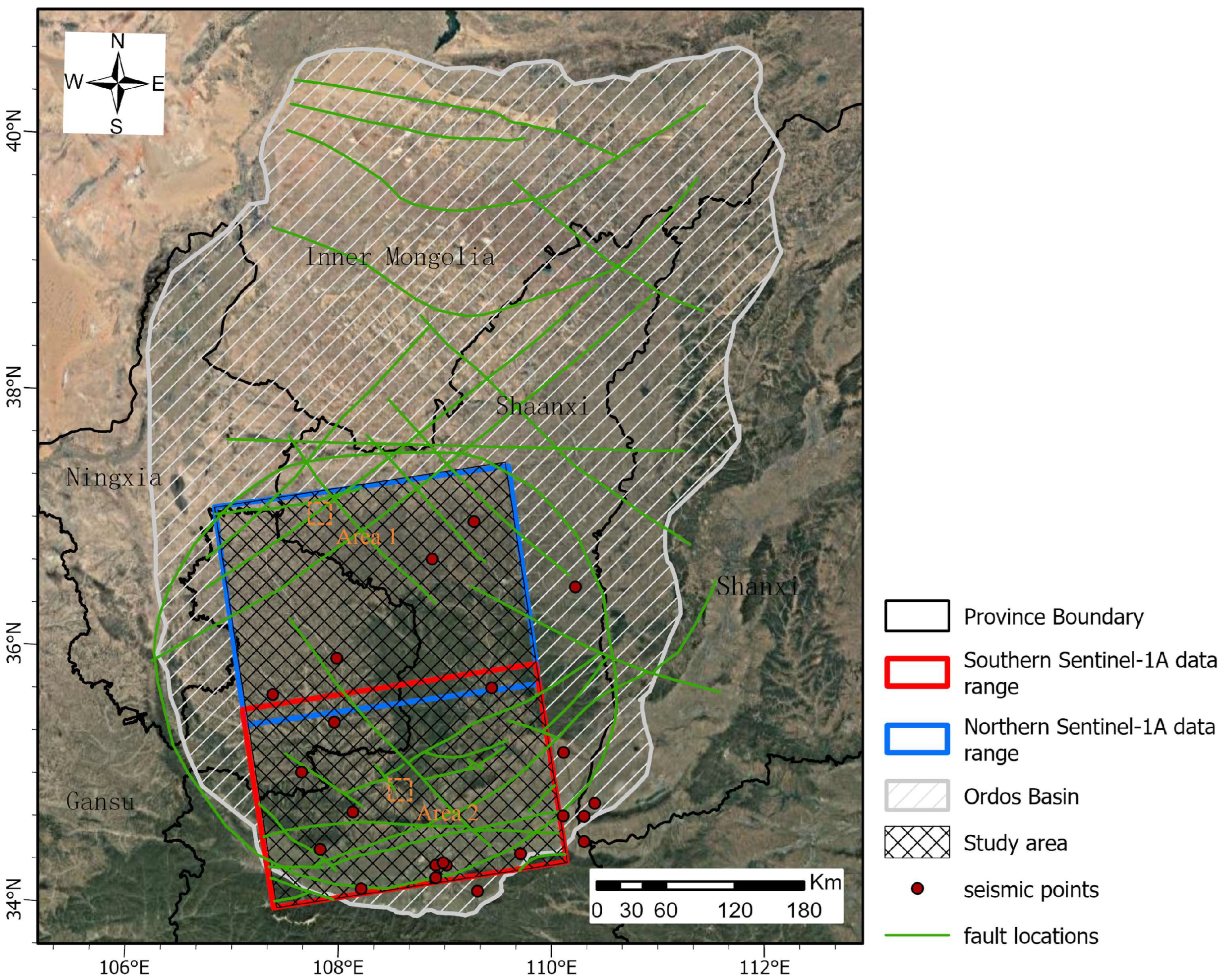
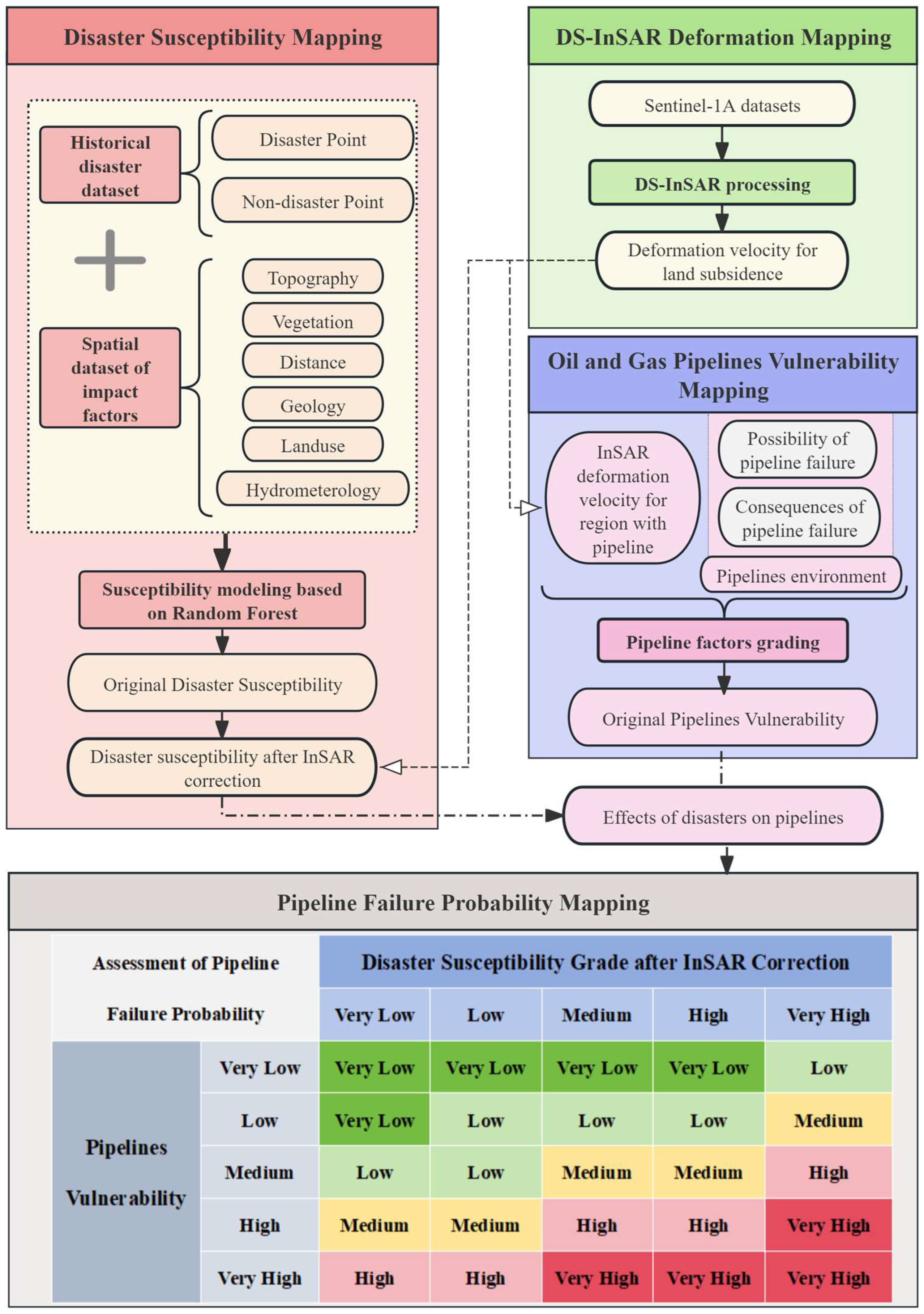
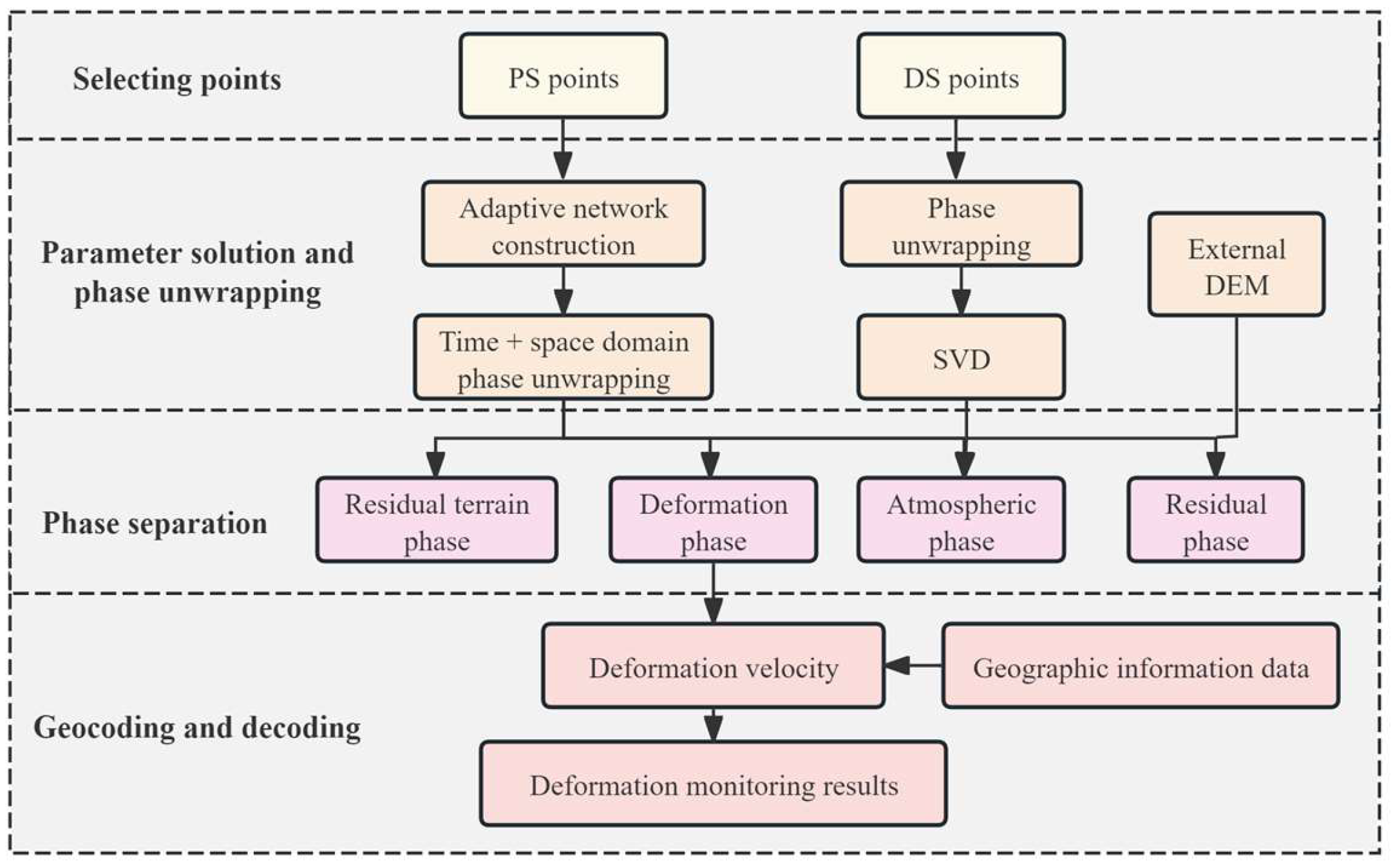

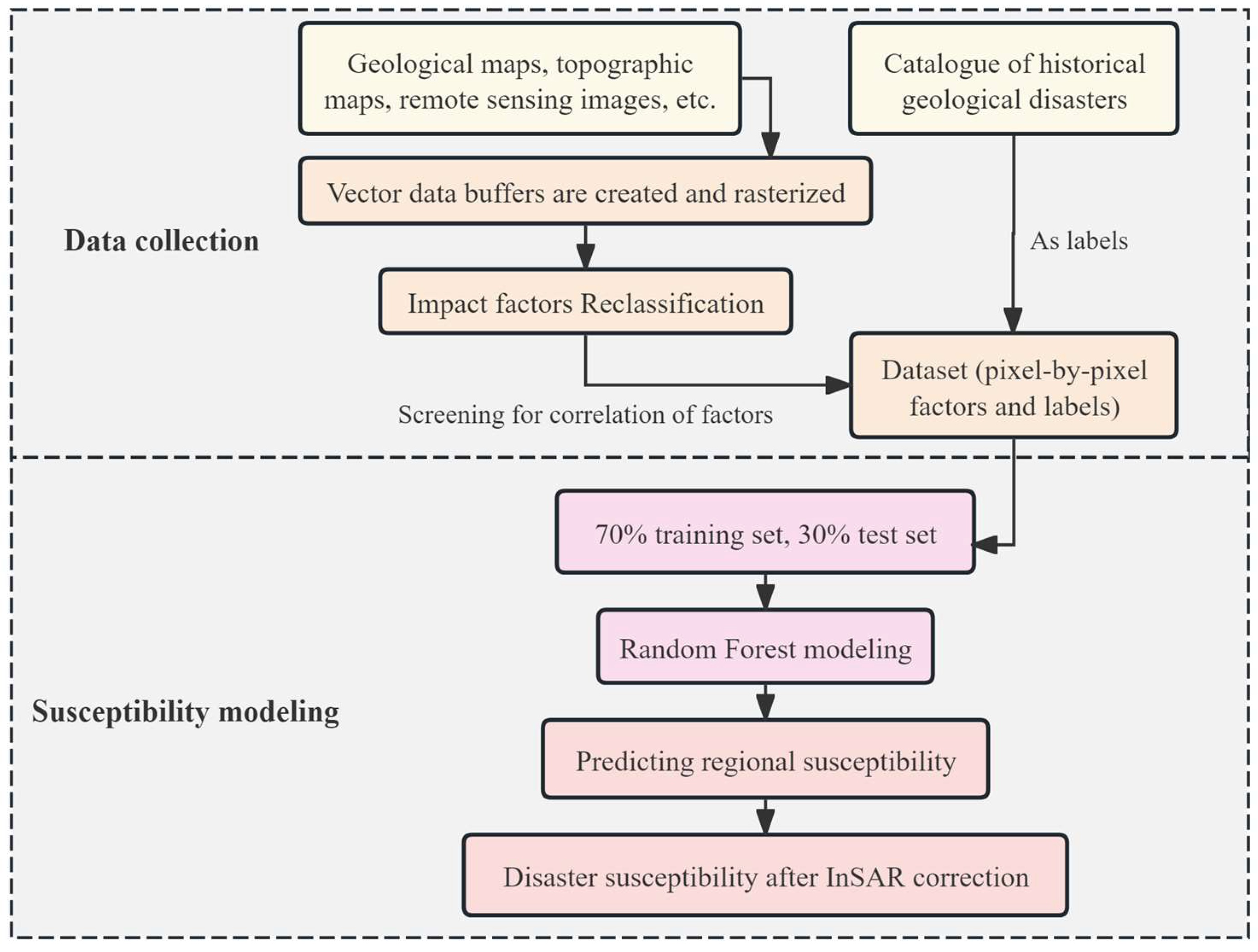
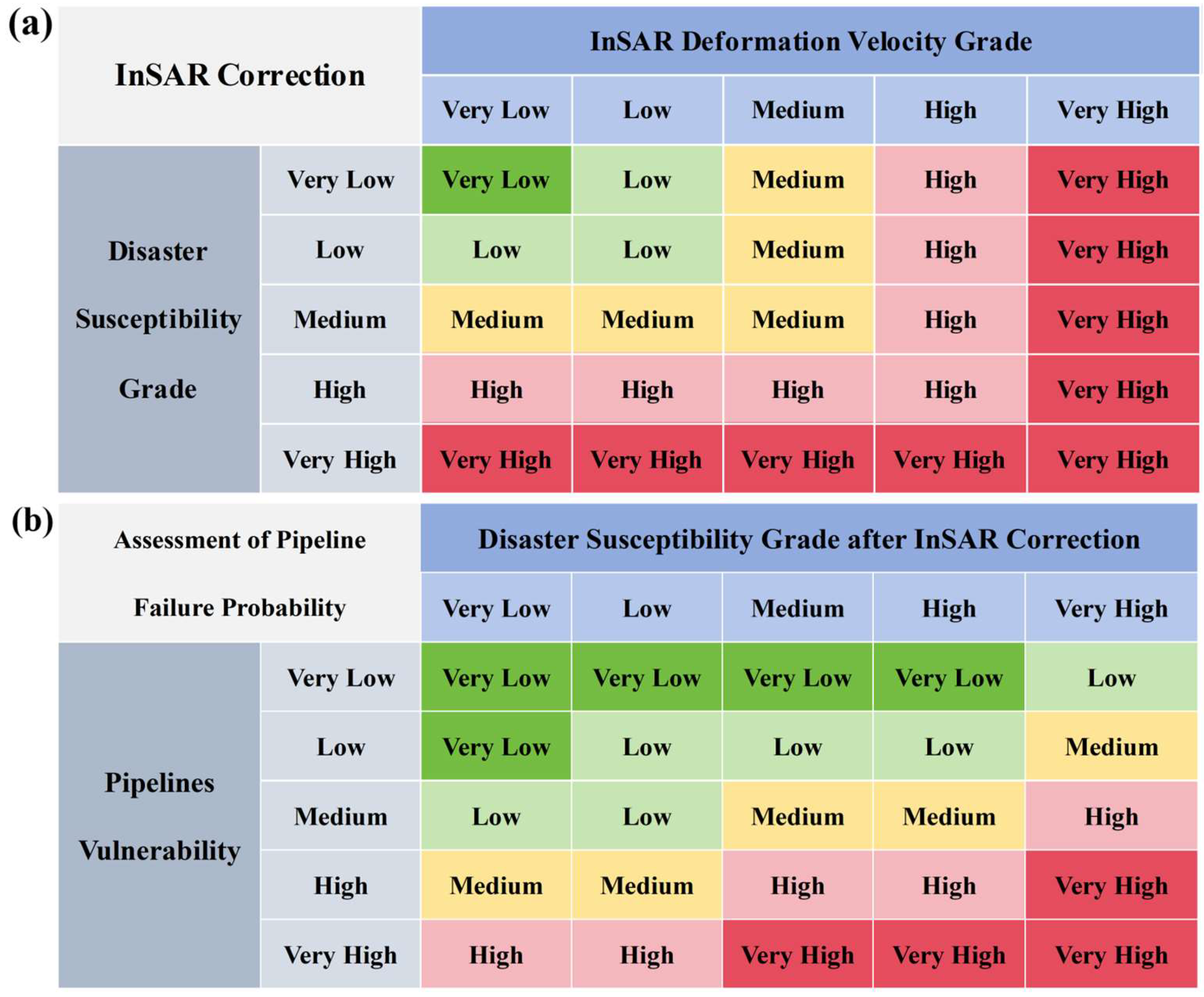
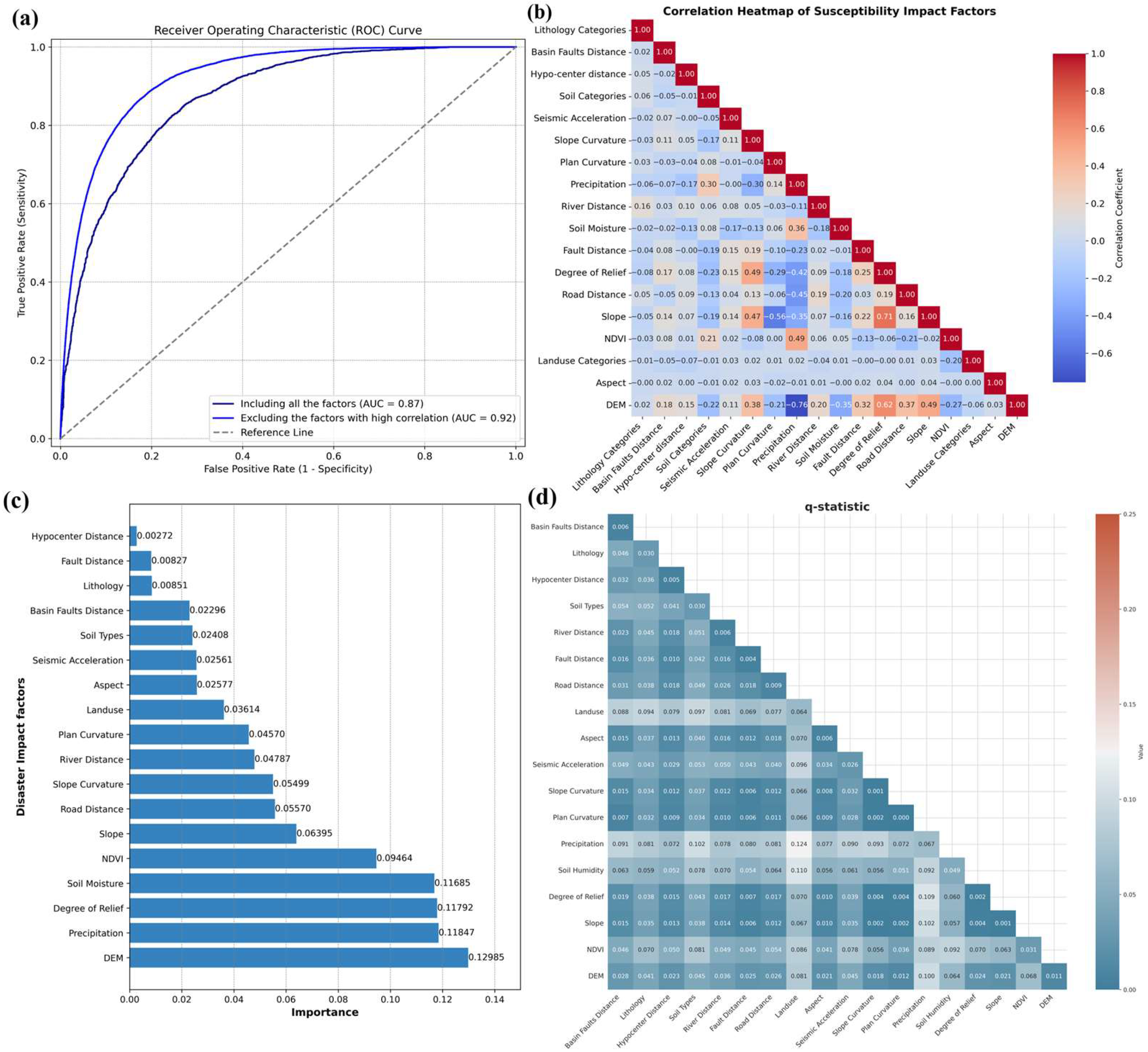
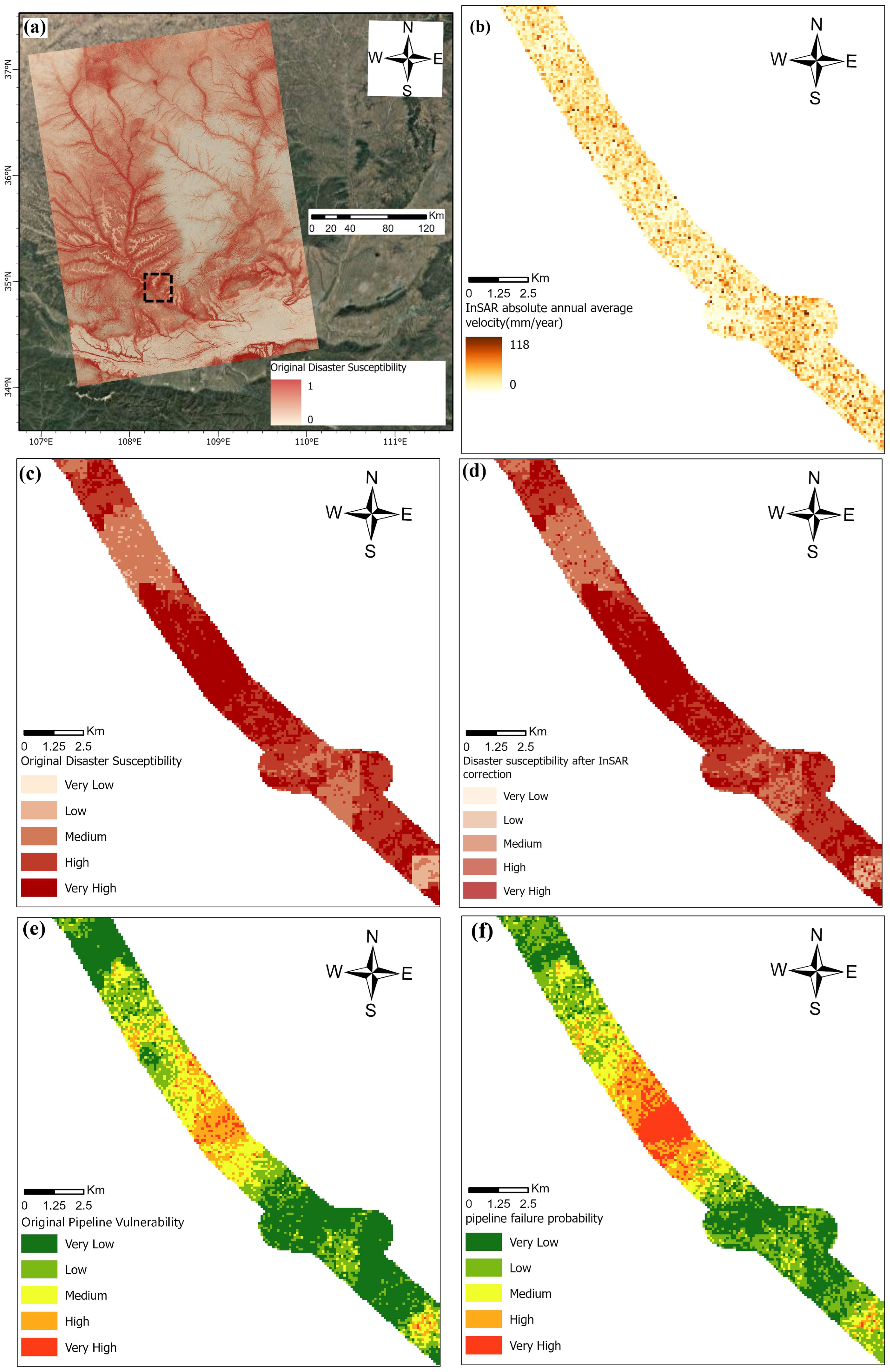
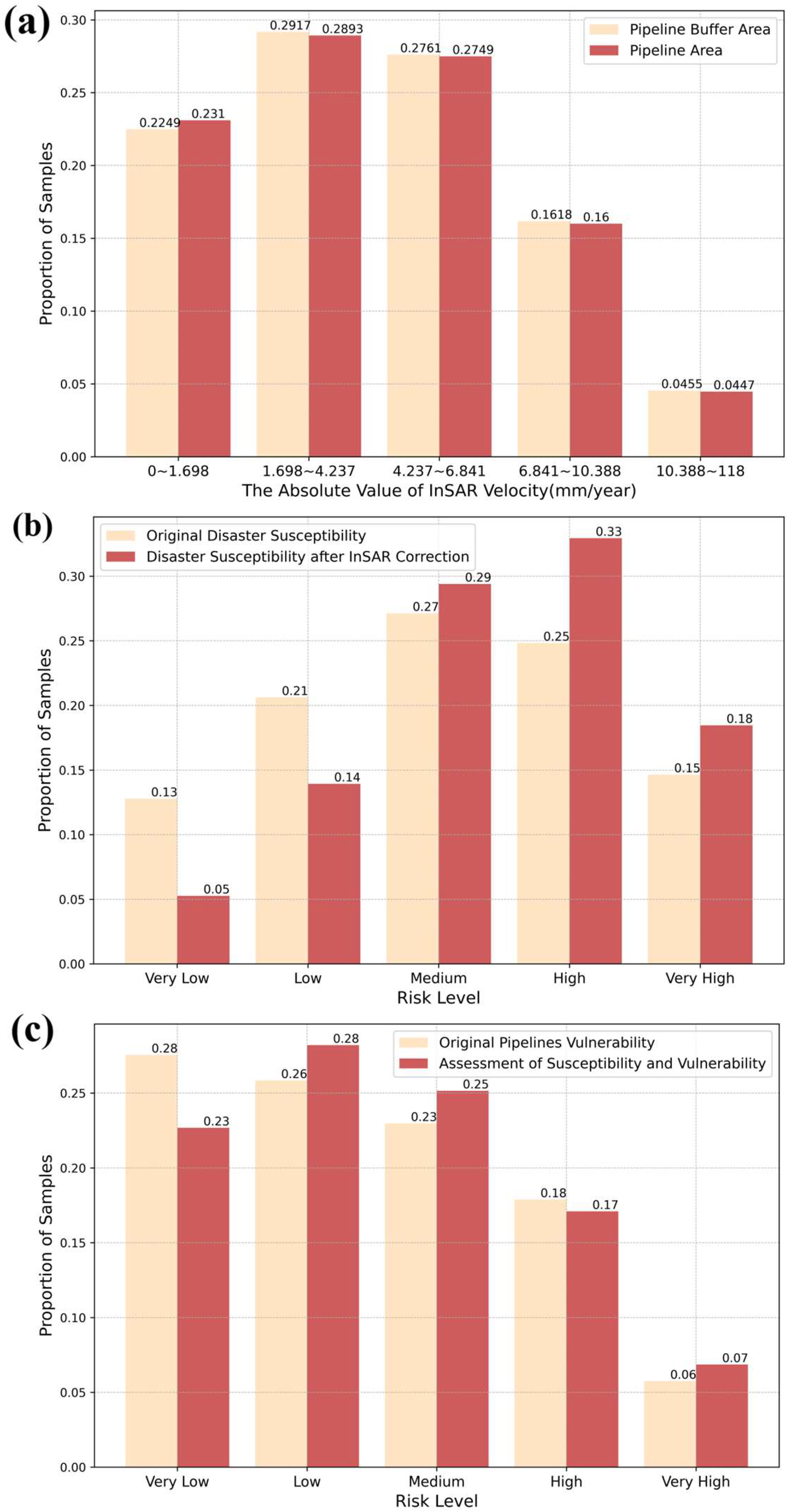

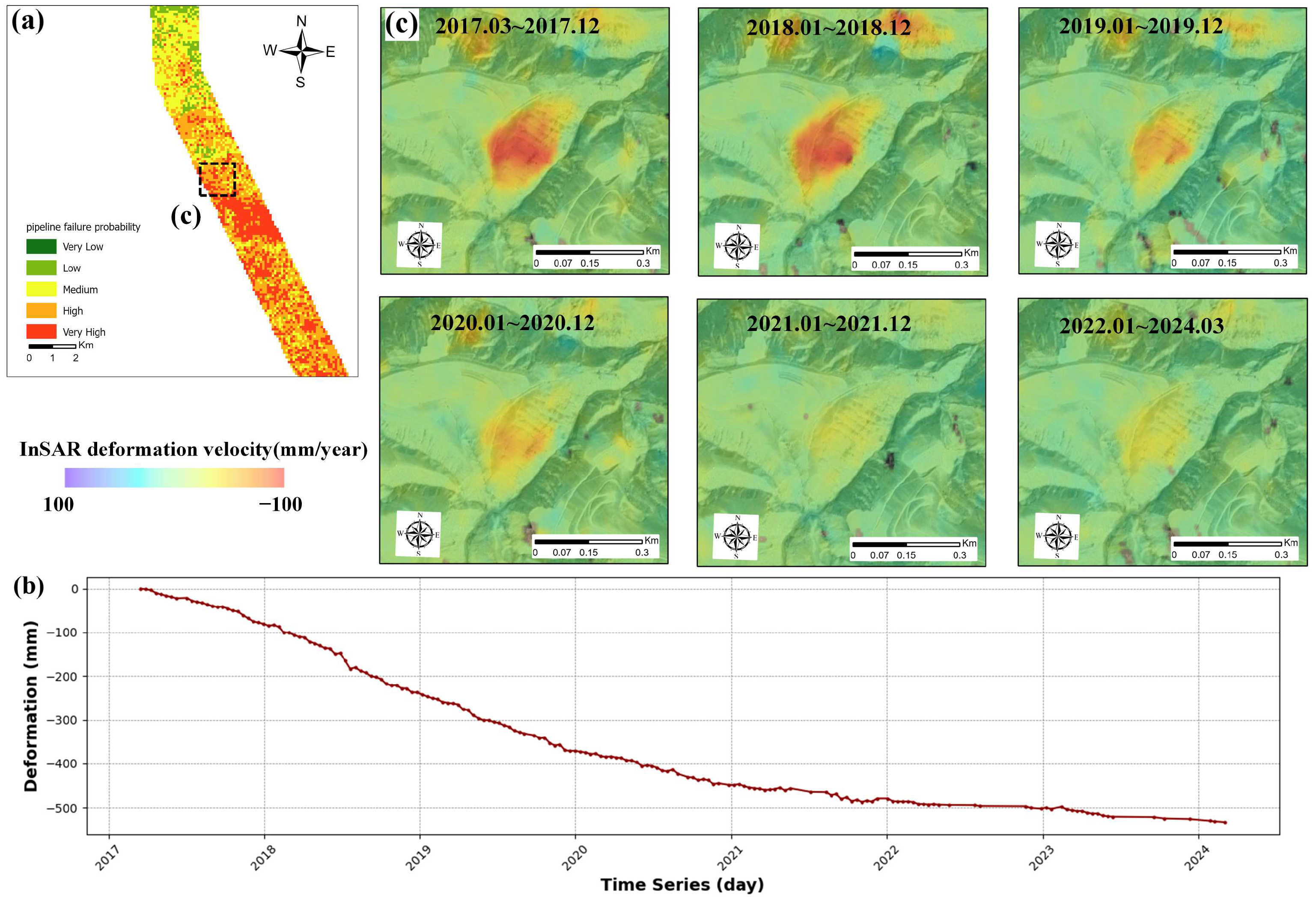
| Period | Number of Views | Orbit of the Southern Area | Orbit of the Northern Area |
|---|---|---|---|
| 20170317–20171230 | 24 | path 83 frame 110 | path 84 frame 115 |
| 20180111–20181225 | 30 | ||
| 20190106–20191220 | 30 | ||
| 20200101–20201226 | 29 | ||
| 20210107–20211209 | 24 | ||
| 20220102–20221228 | 17 | ||
| 20230109–20240304 | 18 |
| Data Type | Feature | Source | Original Spatial Resolution |
|---|---|---|---|
| Topographic data | DEM | SRTM DEM | 30 m |
| Aspect | |||
| Slope | |||
| Slope Curvature | |||
| Plan Curvature | |||
| Degree of Relief | |||
| Land use data | Land use Categories | GlobeLand30 | 30 m |
| Seismic data | Seismic Acceleration | National Earth Data Center (China) | Vector |
| Hypo-center Distance | |||
| Hydro meteorological data | Soil Moisture | SMAP L4 | 9 km |
| Precipitation | GPM | 0.1°(~10 km) | |
| Soil Categories | HWSD | 1 km | |
| River data | River Distance | National 1–5 levels of Standard River data | Vector |
| Fault data | Fault Distance | China 1:2.5 million geological structure line fault database | Vector |
| Basin Faults Distance | |||
| Road data | Road Distance | The OSM road network data | Vector |
| Vegetation data | NDVI | Landsat 8 OLI | 30 m |
| Lithology data | Lithology Categories | China 1:2.5 million stratum lithology spatial distribution database | Vector |
| SAR data | Sentinel-1A SLC data | GMES | 5 × 20 m |
| Oil and gas pipeline data | Oil and gas pipeline | Medium-term and long-term oil and gas pipeline network planning | Vector |
| Pipeline Vulnerability Factors | ||
|---|---|---|
| Pipeline environment | Possibility of pipeline failure | Slope Slope Curvature Plan Curvature Degree of Relief Precipitation Soil Moisture Fault Distance Basin Faults Distance Hypo-center Distance Lithology Categories Soil Categories |
| Consequences of pipeline failure | River Distance Road Distance Land use Categories | |
| InSAR deformation velocity | Absolute velocity for region with pipeline | |
| Vulnerability Factors | Factor Grade | |
|---|---|---|
| InSAR absolute deformation velocity per year Slope Curvature Plan Curvature Degree of Relief Precipitation Soil Moisture | Top 10% of the dataset | 3 |
| Next 10% of the dataset (10–20%) | 2 | |
| Remaining portion of the dataset | 1 | |
| River Distance Fault Distance Basin Faults Distance Road Distance Hypo-center Distance | Within a 2000 m-distance buffer zone | 3 |
| Within a 2000–4000 m-distance buffer zone | 2 | |
| Outside a 4000 m distance buffer zone | 1 | |
| Land use Categories | Wetland and water | 3 |
| Artificial surfaces | 2 | |
| Others | 1 | |
| Lithology Categories | Loess accumulation and Alluvial–fluvial deposits | 3 |
| Clastic rocks and carbonates | 2 | |
| Others | 1 | |
| Soil Categories | Saline-alkaline soil, swamp soil, semi-hydrated soil, and bauxite soil | 3 |
| Leached soil, semi-leached soil, calcium layer soil, and man-made soil | 2 | |
| Others | 1 | |
Disclaimer/Publisher’s Note: The statements, opinions and data contained in all publications are solely those of the individual author(s) and contributor(s) and not of MDPI and/or the editor(s). MDPI and/or the editor(s) disclaim responsibility for any injury to people or property resulting from any ideas, methods, instructions or products referred to in the content. |
© 2025 by the authors. Licensee MDPI, Basel, Switzerland. This article is an open access article distributed under the terms and conditions of the Creative Commons Attribution (CC BY) license (https://creativecommons.org/licenses/by/4.0/).
Share and Cite
Yang, Y.; Liu, Y.; Guo, Y.; Shen, J.; Xie, C.; Zhang, N.; Tian, B.; Zhu, Y.; Mao, Y. An InSAR-Based Framework for Advanced Large-Scale Failure Probability Assessment of Oil and Gas Pipelines. Remote Sens. 2025, 17, 504. https://doi.org/10.3390/rs17030504
Yang Y, Liu Y, Guo Y, Shen J, Xie C, Zhang N, Tian B, Zhu Y, Mao Y. An InSAR-Based Framework for Advanced Large-Scale Failure Probability Assessment of Oil and Gas Pipelines. Remote Sensing. 2025; 17(3):504. https://doi.org/10.3390/rs17030504
Chicago/Turabian StyleYang, Yanchen, Yang Liu, Yihong Guo, Jinli Shen, Chou Xie, Nannan Zhang, Bangsen Tian, Yu Zhu, and Ying Mao. 2025. "An InSAR-Based Framework for Advanced Large-Scale Failure Probability Assessment of Oil and Gas Pipelines" Remote Sensing 17, no. 3: 504. https://doi.org/10.3390/rs17030504
APA StyleYang, Y., Liu, Y., Guo, Y., Shen, J., Xie, C., Zhang, N., Tian, B., Zhu, Y., & Mao, Y. (2025). An InSAR-Based Framework for Advanced Large-Scale Failure Probability Assessment of Oil and Gas Pipelines. Remote Sensing, 17(3), 504. https://doi.org/10.3390/rs17030504






